Info
Subfamily: Pooideae
Genus etymology: Gastridium = "small belly" [Greek] refering to the sowllen glumes
Species etymology: phleoides = "resembling the genus Phleum L." refering to the inflorescence
Photosynthetic type: C3 (cool season)
Nativity: naturalized - accidental
First recorded in Hawaiʻi: 1902
Map

Inflorescence
 image credit: Forest & Kim Starr
image credit: Forest & Kim StarrPlant
 image credit: Forest & Kim Starr
image credit: Forest & Kim StarrSpikelets
 image credit: Forest & Kim Starr
image credit: Forest & Kim StarrDescription
Annual. Culms up to 60 cm. high, slender, erect or geniculately ascending. Leaf-blades 2.5–15 cm. long and 1–4 mm. wide, rough, acute; ligule 2–7 mm. long. Panicle linear-oblong to lanceolate, up to 18 cm. long and 1.5 cm. wide, dense, pale green; pedicels with thickened tips. Spikelets linear-oblong, 5–7.5 mm. long, the rhachilla produced as a fine hairy bristle; glumes finely acute, the lower as long as the spikelet, the upper 4–5 mm. long; lemma up to 1.5 mm. long, loosely to densely pubescent, bearing an awn up to 7 mm. long. Fig. 34, p. 101.
(Description source: Clayton, W.D. 1970. Flora of Tropical East Africa. Gramineae (Part 1). Crown Agents for Oversea Governments and Administrations, London. 176 pp. )
Habit: Annual; culms solitary, or caespitose. Culms erect, or decumbent; 10-60 cm long. Ligule an eciliate membrane; 1-3 mm long. Leaf-blades 2-10 cm long; 2-4 mm wide. Leaf-blade surface scaberulous; rough on both sides. Inflorescences: Inflorescence a panicle. Panicle spiciform; lanceolate to oblong; 2-10 cm long; 0.5-1.2 cm wide. Spikelets solitary. Fertile spikelets pedicelled. Pedicels linear; 0.5-2 mm long; scaberulous; tip pyriform. Spikelets: Spikelets comprising 1 fertile florets; without rhachilla extension. Spikelets oblong; laterally compressed; 3-4.8 mm long; breaking up at maturity; disarticulating below each fertile floret. Floret callus obtuse. Fertile Spikelets: Spikelets comprising 1 fertile florets; without rhachilla extension. Spikelets oblong; laterally compressed; 3-4.8 mm long; breaking up at maturity; disarticulating below each fertile floret. Floret callus obtuse. Glumes: Glumes persistent; similar; exceeding apex of florets; firmer than fertile lemma; shiny. Lower glume lanceolate; saccate; 1.3 length of upper glume; 1 length of spikelet; scarious; 1-keeled; keeled above; 1 -veined. Lower glume primary vein scaberulous. Lower glume lateral veins absent. Lower glume apex acute. Upper glume lanceolate; saccate; 2.25-3.5 mm long; 2-3 length of adjacent fertile lemma; scarious; much thinner above; 1-keeled; keeled above; 1 -veined. Upper glume primary vein scaberulous. Upper glume lateral veins absent. Upper glume apex acuminate. Florets: Fertile lemma orbicular; 1 mm long; cartilaginous; without keel; 5 -veined. Lemma surface glabrous, or pubescent; hairy in the middle (on flanks). Lemma apex erose; truncate; muticous, or awned; 1 -awned. Principal lemma awn dorsal; arising 0.8 way up back of lemma; geniculate; 0-4 mm long overall; not or scarcely exserted from spikelet; with twisted column. Palea 1 length of lemma; cartilaginous; 2 -veined. Flowers: Anthers 3; 0.6-0.8 mm long. Fruits: Caryopsis with adherent pericarp. Hilum punctiform. Distribution: Europe: northern, southwestern, and southeastern. Africa: north and Macaronesia. Asia-temperate: Caucasus and western Asia. Australasia: Australia and New Zealand. Pacific: south-central and north-central. North America: eastern Canada, northwest USA, northeast USA, southwest USA, and Mexico. South America: western South America and southern South America.
(Description source: Clayton, W.D., Vorontsova, M.S., Harman, K.T. and Williamson, H. (2006 onwards). GrassBase - The Online World Grass Flora. Available at https://powo.science.kew.org )
Tufted annuals, leaves usually few; culms 20-55 cm tall, glabrous. Sheaths 2-7 cm long, glabrous, striate; ligule membranous, usually lacerate, 6-7 mm long, nerved, scaberulous on the nerves; blades thin, 8-25 cm long, 1-7 mm wide, scabrous. Panicles pale green or yellowish brown, glossy, dense, spike-like, narrowly cylindrical, 4-10 cm long, 0.7-1.2 cm wide; spikelets 4-6 mm long, slender; glumes slender, attenuate, somewhat swollen and glabrous at base, keeled and scabrous in upper part, margins hyaline, first glume 4.5-5 mm long, second glume 6-7 mm long; lemma 1- 1.2 mm long, truncate, awn delicate, yellowish, 5-6 mm long; palea ca. 1 mm long, pilose at base, bifid. Caryopsis reddish brown, ovoid, ca. 1 mm long. [2n = 14, 28.]
(Description source: O’Connor, P.J. 1990. Poaceae, pp. 1481–1604. In: Wagner W.L., Herbst D.R. & Sohmer S.H. (eds.)., Manual of the flowering plant of Hawaiʻi. Vol. 2. University of Hawaii Press & Bishop Museum Press, Honolulu )